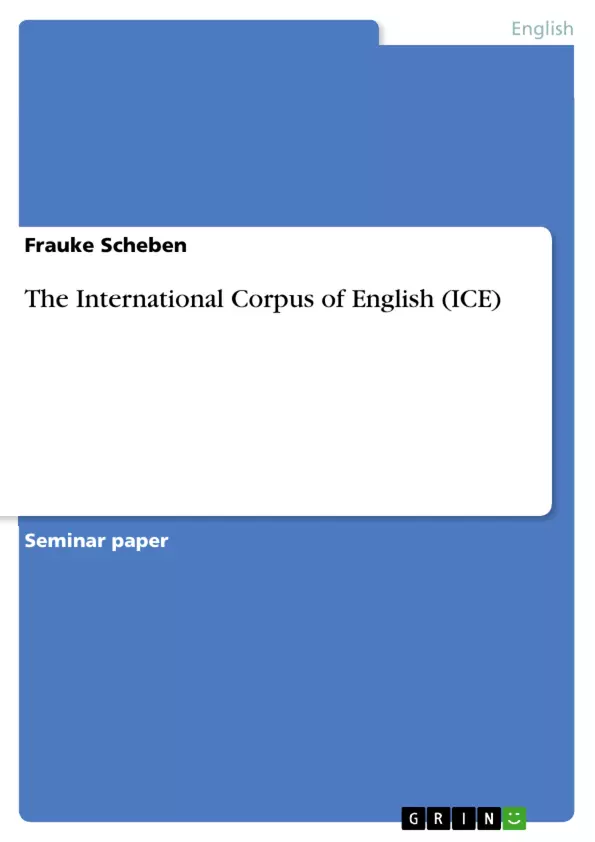This paper deals with the International Corpus of English (ICE), which is an international project that was initiated by Professor Sidney Greenbaum in 1988. His book“Comparing English Worldwide”has been a very helpful resource for writing this paper.
Many countries and people have been - and still are presently - involved in the research and compilation of corpora. It is the corpora of eighteen countries from all over the world that make up the International Corpus of English. The paper gives information on the design and structure of the International Corpus, in general and in depth, with focus on the division into a written and spoken category of texts. The paper mainly talks about what the corpora of the ICE have in common and not so much about the individual differences among them.
Furthermore, the paper explains the theoretical given facts of text categories and the two different ways this particular corpus was annotated: textual and biographical/bibliographical markup.
Last but not least, one will briefly learn about the ICE Corpus Utility Program, which was especially developed in order to simplify the analysis of and ease the access to the ICE.
Inhaltsverzeichnis (Table of Contents)
- Introduction
- Information on the Background
- The ICE Project
- Participating Countries
- Professors and Helpers
- The Structure of the ICE
- General Facts
- Information in Detail
- Written Texts
- Spoken Texts
- Texts
- Subtexts
- Text Units
- Extra-Corpus Text
- Corpus Annotation
- Textual Markup
- Biographical/Bibliographical Markup
- ICECUP
- Closing
Zielsetzung und Themenschwerpunkte (Objectives and Key Themes)
This paper explores the International Corpus of English (ICE), a collaborative project initiated by Professor Sidney Greenbaum in 1988. The paper examines the design and structure of the ICE, its participating countries, and its annotation methods.
- The history and development of the ICE project
- The structure and organization of the ICE corpus
- The differences between spoken and written texts in the ICE
- The annotation methods used in the ICE corpus
- The purpose and functionalities of the ICE Corpus Utility Program (ICECUP)
Zusammenfassung der Kapitel (Chapter Summaries)
The paper begins with an introduction to the International Corpus of English (ICE), outlining its goals and scope. It then delves into the background of the project, highlighting the contributions of Professor Sidney Greenbaum and the motivations behind its creation. The paper further explores the participating countries, discussing the differences in data collection and analysis between countries where English is a first language and those where it is a second language.
The paper then dives into the structure of the ICE, providing an overview of its organization and the categorization of texts into written and spoken categories. It details the specific features of each category, including the types of texts included and their respective subcategories.
The paper concludes with a discussion on the annotation methods used in the ICE, focusing on the distinction between textual markup and biographical/bibliographical markup. Finally, the paper briefly introduces the ICE Corpus Utility Program (ICECUP), a dedicated program developed for analysis and access to the ICE corpus.
Schlüsselwörter (Keywords)
This paper primarily focuses on the International Corpus of English (ICE), its design, structure, and the annotation methods used. The paper explores the differences between spoken and written English in the ICE, highlighting the diverse participating countries and the challenges associated with data collection in second language contexts. Additionally, the paper mentions the ICE Corpus Utility Program (ICECUP) as a tool for analysis and access to the corpus.
- Quote paper
- M.A. Frauke Scheben (Author), 2002, The International Corpus of English (ICE), Munich, GRIN Verlag, https://www.grin.com/document/55689



